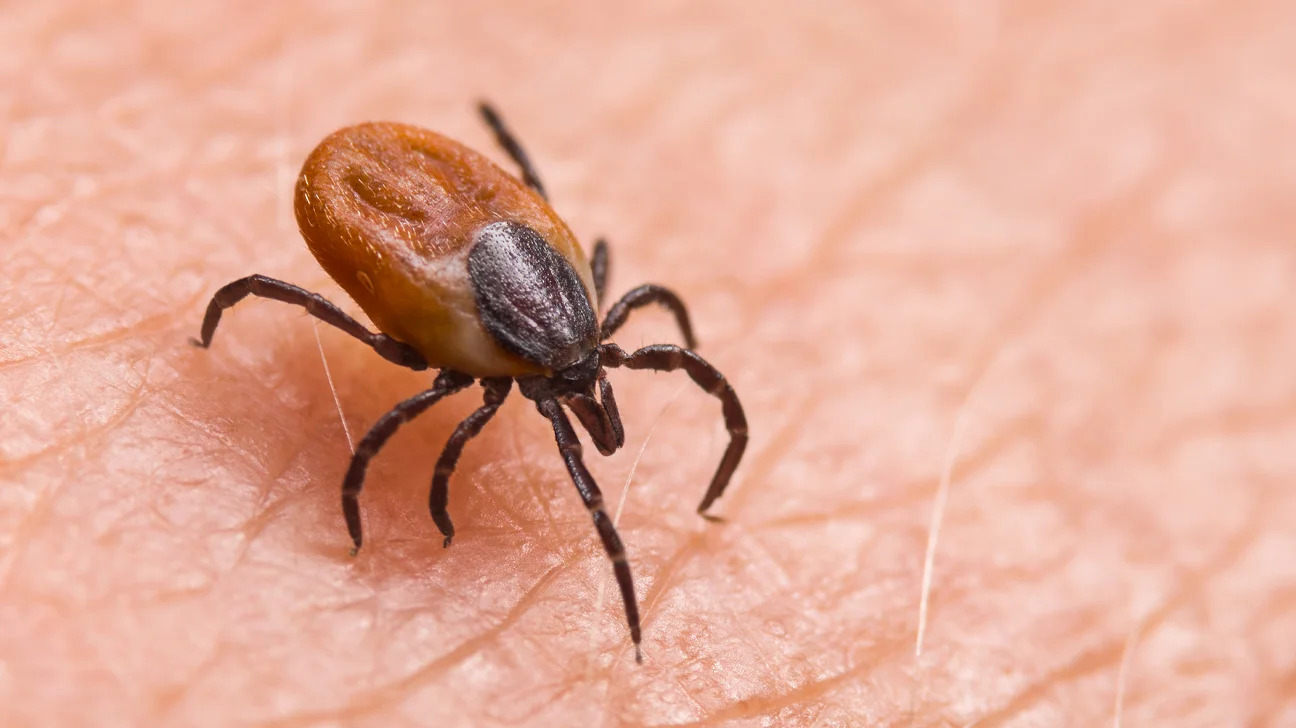Home>Gardening News and Trends>Latest News>What Insects Burrow Under The Skin


Latest News
What Insects Burrow Under The Skin
Modified: January 22, 2024
Discover the latest news on insects that burrow under the skin, including their identification, prevention, and treatment options. Stay informed and protect yourself from these invasive pests.
(Many of the links in this article redirect to a specific reviewed product. Your purchase of these products through affiliate links helps to generate commission for Chicagolandgardening.com, at no extra cost. Learn more)
Table of Contents
Introduction
Having insects burrow under the skin can be a distressing and uncomfortable experience. These tiny creatures can cause irritation, pain, and even infection as they make their way into the body. While it may seem like something out of a horror movie, it is a real phenomenon that can happen to anyone. In this article, we will explore the types of insects that burrow under the skin, the symptoms to watch out for, how to diagnose and treat the infestation, as well as prevention tips to keep these insects at bay.
There are several types of insects that are known to burrow under the skin. Some of the most common culprits include fleas, ticks, mites, and certain species of flies. These insects have specialized mouthparts or structures that allow them to penetrate the skin and feed on blood or tissue fluids. While their primary goal is to find a warm and cozy place to live and reproduce, their presence can cause a range of symptoms and complications.
Identifying an insect infestation can be challenging as the symptoms can vary depending on the type of insect involved. However, there are some common signs to look out for. These may include intense itching or a crawling sensation, redness or inflammation at the site of entry, small bumps or blisters, and even the presence of a visible burrow or tunnel under the skin. It’s important to note that not all insect bites or skin reactions are a result of burrowing insects, as some insects may simply bite or sting without leaving any traces under the skin.
Diagnosing an insect infestation requires a careful examination of the affected area and, in some cases, additional tests. A healthcare professional may perform a skin biopsy to observe the presence of the insect or its eggs. They may also order blood tests to check for any signs of infection or allergic reactions. Additionally, if the infestation is suspected to be caused by a specific insect, such as ticks, samples may be sent to a laboratory for identification.
Types of Insects that Burrow Under the Skin
There are several types of insects that have the ability to burrow under the skin, causing discomfort and potential health risks. Let’s take a closer look at some of the common culprits:
- Fleas: Fleas are small, wingless insects that are typically associated with infesting pets like cats and dogs. However, they can also bite humans and burrow into their skin. Flea bites often appear as red, itchy bumps or clusters of small blisters and can be accompanied by intense itching.
- Ticks: Ticks are arachnids that are known for transmitting diseases like Lyme disease. When a tick bites, it burrows its mouthparts into the skin to feed on blood. They prefer warm and moist areas of the body, such as the armpits, groin, and scalp. If left untreated, tick bites can lead to complications like infections or allergic reactions.
- Mites: Mites are tiny arachnids that can burrow under the skin and cause conditions such as scabies or chigger bites. Scabies is a highly contagious skin infestation that causes intense itching and a pimple-like rash. Chigger bites, on the other hand, often occur in areas with tall grass or vegetation and result in red, itchy welts on the skin.
- Certain Species of Flies: Certain species of flies, such as tumbu flies or botflies, lay their eggs on the skin of animals or humans. Once the eggs hatch, the larvae burrow into the skin and develop. This can cause painful swelling, redness, and the formation of a boil-like lesion known as a furuncle.
It’s important to note that different insects have different methods of burrowing and characteristic symptoms. Additionally, the geographical location and environmental factors can influence the prevalence of specific types of burrowing insects.
Common Symptoms and Signs of Insect Infestation
When it comes to an insect infestation under the skin, there are several common symptoms and signs to be aware of. These can vary depending on the type of insect involved, but here are some general indicators to look out for:
- Intense Itching: One of the most common symptoms of an insect infestation is intense itching at the site of the bite or entry. This itching may be persistent and difficult to alleviate, leading to discomfort and potential skin damage from scratching.
- Crawling Sensation: Many individuals who have experienced an insect burrowing under their skin describe a crawling sensation. This can feel like something is moving or wriggling beneath the skin and can be highly unsettling.
- Redness and Inflammation: Insect bites or entry points may appear red and inflamed due to the body’s immune response. This inflammation can range from mild to severe, depending on the individual’s sensitivity to the insect’s saliva or other substances.
- Bumps or Blisters: Some insect infestations can result in the formation of small bumps or blisters on the skin. These can be raised, filled with fluid, or resemble a rash. They may be localized to the area of the insect’s entry or spread to adjacent areas.
- Visible Burrows or Tunnels: In certain cases, particularly with mites or certain flies, it may be possible to see visible burrows or tunnels under the skin. These can appear as thin, raised lines or tracks and are often accompanied by itching and irritation.
- Allergic Reactions: Some individuals may experience an allergic reaction to insect bites or the substances they release under the skin. This can manifest as hives, swelling, difficulty breathing, or other symptoms of an allergic response.
It’s essential to remember that these symptoms are not exclusive to insect infestations and can also be caused by other conditions. If you suspect an infestation or experience persistent symptoms, it is advisable to seek medical attention for a proper diagnosis.
Diagnosis and Tests for Insect Burrowing Under the Skin
Diagnosing an insect infestation that involves burrowing under the skin can be challenging, as the symptoms can be similar to other skin conditions. However, with a careful examination and additional tests, healthcare professionals can determine the presence of an insect infestation. Here are some common diagnostic methods and tests that may be used:
- Visual Examination: A healthcare professional will first conduct a visual examination of the affected area. They will look for signs of entry points, such as bites, puncture marks, or visible burrows. The appearance of the rash, swelling, or any other skin abnormalities will also be considered.
- Skin Scraping: In some cases, a skin scraping may be performed to collect a sample from the affected area. The healthcare professional will gently scrape the skin surface to obtain cells or any debris that may contain the insect or its eggs. The sample is then examined under a microscope for further investigation.
- Skin Biopsy: If the infestation is severe or the specific type of insect involved is difficult to identify, a skin biopsy may be recommended. During this procedure, a small piece of skin tissue is removed and sent to a laboratory for analysis. The sample is examined under a microscope to identify the presence of insects, their eggs, or any related signs of infection or inflammation.
- Blood Tests: In certain situations, blood tests may be ordered to check for any signs of infection or allergic reactions. These tests can help determine if the insect bite has led to the development of an infection or if the individual has developed an allergic response to the insect’s saliva or other substances.
- Extraction of the Insect: If the healthcare professional is able to locate the insect, special instruments may be used to extract it from the skin. Once the insect is removed, it can be examined to identify the species and determine any necessary treatment.
It’s important to note that the diagnostic process may vary depending on the healthcare provider and the suspected insect infestation. It’s best to consult a medical professional with experience in dermatology or entomology to ensure an accurate diagnosis and appropriate treatment plan.
Treatment Options for Insect Burrowing Under the Skin
When dealing with an insect burrowing under the skin, prompt treatment is essential to alleviate symptoms, prevent complications, and remove the intruding insect. The specific treatment approach may vary depending on the type of insect and the severity of the infestation. Here are some common treatment options:
- Topical Treatment: For mild infestations, topical creams or ointments may be prescribed to reduce inflammation, alleviate itching, and kill or repel the insects. These products may contain ingredients such as corticosteroids, antihistamines, antiparasitic agents, or soothing substances to provide relief.
- Oral Medication: In more severe cases or when the infestation has spread to other parts of the body, oral medication may be necessary. This can include antiparasitic drugs or antibiotics to combat any associated infections. It’s essential to follow the prescribed dosage and duration as instructed by a healthcare professional.
- Surgical Removal: In some instances, particularly with larger insects like ticks or botfly larvae, surgical removal may be required. A healthcare professional will perform a minor surgical procedure to lift or extract the insect from the skin. This is often done using sterile instruments to minimize the risk of infection.
- Hygiene Practices: Practicing good hygiene can aid in the treatment and prevention of insect infestations. Regularly washing the affected area with mild soap and water can help clean the skin and reduce the risk of infection. Additionally, keeping the skin clean and dry can discourage further breeding or infestation.
- Preventing Secondary Infections: As an infestation can lead to an increased risk of secondary infections, it’s important to keep the affected area clean and apply any prescribed topical antiseptics or antibiotics as instructed by a healthcare professional. This helps prevent or treat any bacterial or fungal infections that may develop as a result of scratching or compromised skin.
- Preventing Reinfection: After receiving treatment for an insect burrowing under the skin, it’s crucial to take precautions to avoid reinfection. This may include using insect repellents, wearing protective clothing, regularly checking for ticks or other pests after being in infested areas, and keeping living spaces and bedding clean and free from pests.
It’s important to consult a healthcare professional for an accurate diagnosis and appropriate treatment plan, as they can provide personalized recommendations based on the specific infestation and the individual’s medical history.
Prevention Tips to Avoid Insect Infestation
Preventing insect infestations that involve burrowing under the skin is key to avoiding the discomfort and potential health risks associated with these pests. Here are some effective prevention tips to keep in mind:
- Use Insect Repellent: Apply insect repellent containing DEET, picaridin, or other effective ingredients to exposed skin and clothing when spending time outdoors, especially in areas known for high insect activity.
- Wear Protective Clothing: Cover the skin by wearing long sleeves, pants, and closed-toe shoes when venturing into areas where insects may be present, such as wooded areas or grassy fields.
- Inspect and Secure Your Home: Regularly inspect your home for any cracks, gaps, or openings that pests can use as entry points. Seal these areas and use screens on windows and doors to prevent insects from getting inside.
- Maintain a Clean Living Environment: Keep your living space clean and tidy. Regularly vacuum carpets and clean bedding to reduce the presence of pests. Dispose of trash properly and keep food containers tightly sealed.
- Protect Your Pets: Keep your pets protected from fleas, ticks, and other insects with regular use of veterinarian-recommended flea and tick prevention products. Additionally, inspect your pets regularly for signs of infestation and consult a veterinarian if necessary.
- Avoid Infested Areas: If you know certain areas are known to be infested with specific insects, try to avoid them as much as possible. Be mindful of camping spots, hiking trails, or other outdoor areas where insects are prevalent.
- Stay Away from Stray Animals: Stray animals can carry parasites, including fleas and ticks. Avoid contact with stray animals and report any sightings to local authorities or animal control.
- Be Cautious in High-Risk Areas: Take extra precautions in areas known for specific insect infestations. For example, be diligent when hiking in tick-prone areas by wearing appropriate clothing and performing regular tick checks.
- Educate Yourself: Learn about the common insects in your area and their behaviors. Understanding their habits and preferred habitats can help you take appropriate precautions and recognize the signs of an infestation.
By following these prevention tips, you can significantly reduce the risk of insect infestations that burrow under the skin. However, if you suspect an infestation or experience persistent symptoms, it is advisable to seek medical attention for proper diagnosis and treatment.
When to Seek Medical Help
While many cases of insect infestations that burrow under the skin can be treated at home or with over-the-counter remedies, there are instances where medical attention should be sought. Here are some situations where it is important to consult a healthcare professional:
- Severe Symptoms: If you experience severe symptoms such as intense pain, excessive swelling, difficulty breathing, or signs of a severe allergic reaction (e.g., hives, dizziness, or swelling of the face or throat), seek immediate medical attention. These symptoms may indicate a more serious complication or infection.
- Persistent Symptoms: If your symptoms persist or worsen despite at-home treatments, it is advisable to schedule a visit with a healthcare professional. They can conduct a thorough examination, provide a proper diagnosis, and recommend a more targeted treatment plan.
- Unidentified Insect or Infestation: If you are unsure of the type of insect involved or cannot identify the infestation, it is best to consult a medical professional. They can gather relevant information, perform necessary tests or examinations, and provide appropriate guidance or treatment.
- Multiple Insect Bites or Widespread Infestation: If you have multiple insect bites or a widespread infestation affecting several areas of your body, it may require medical attention. This can help prevent further complications and ensure proper treatment of the infestation.
- Excessive Itching or Skin Damage: If your itching is severe and uncontrollable, leading to excessive scratching and skin damage, medical intervention may be necessary. Healthcare professionals can help manage the itching and provide additional remedies to promote healing.
- Underlying Conditions: If you have pre-existing medical conditions or compromised immune function, it is important to consult a healthcare professional. They can assess the potential impact of the infestation on your health and provide appropriate treatment or recommendations.
It’s always better to err on the side of caution and seek medical help if you are unsure or concerned about your symptoms. A healthcare professional can offer the necessary expertise and guidance to ensure proper diagnosis, treatment, and management of the insect infestation.
Conclusion
Insect infestations that involve burrowing under the skin can be uncomfortable, distressing, and potentially pose health risks. Understanding the types of insects that can cause these infestations, recognizing the common symptoms, and knowing the available treatment options are crucial in managing and preventing such incidents.
From fleas and ticks to mites and certain species of flies, various insects have the ability to burrow under the skin. Identifying an infestation can be challenging, as symptoms can overlap with other skin conditions. However, seeking medical help and undergoing appropriate diagnostic tests, such as skin scrapings or biopsies, can aid in accurate detection.
Treatment options may include topical or oral medications, surgical removal of the insect, and practicing good hygiene. Additionally, prevention is key in avoiding insect infestations. Using insect repellents, wearing protective clothing, and maintaining a clean living environment are effective measures to reduce the risk of infestation.
Knowing when to seek medical help is crucial. Severe symptoms, persistent or worsening symptoms, unidentified insects or infestations, widespread infestations, excessive itching, and underlying medical conditions warrant immediate attention from a healthcare professional.
In conclusion, being knowledgeable about insect infestations that burrow under the skin empowers individuals to take proactive steps in prevention, seek timely treatment, and minimize potential complications. By incorporating preventive measures and seeking appropriate medical support when needed, individuals can effectively manage and reduce the impact of these infestations on their health and well-being.









